22 Fun Facts About Axolotls Even You Don’t Know!
Axolotls are aquatic creatures that resemble salamanders. Learn some fun facts about the species to understand Axolotls better.
Pet keepers love this aquatic animal because of its many colors ranging from black, brown, and white with gold and olive specks. It is also called Mexican walking fish and can live for more than 15 years in captivity. It’s not picky on its food, alive or dead, making it inexpensive to feed. Due to its endangered nature, it’s rare to get a sighting of this sea creature in the wild.
What are some facts about Axolotls?
Some of the fun facts about Axolotls are that they don’t mature, they regenerate, suction their food, don’t chew food, and some people keep them as pets. In addition, the species come in various colors, the male and female dance during mating, and they are carnivorous.
Having Axolotl as a pet will keep you entertained as it loves to burrow through the sand as it searches for food. They do not chew its food but rather suction it and use the sand that sneaks in with the food to grind the food for easier digestion.
You will have a show on your hands during the breeding season as the male and female Axolotl mate through a dance.
You’d better get yourself Axolotl for your aquarium if you want to enjoy seeing the mating dance. It will also help enhance your living room aesthetics and keep you busy when idle. Read to find out more fun facts about Axolotl.
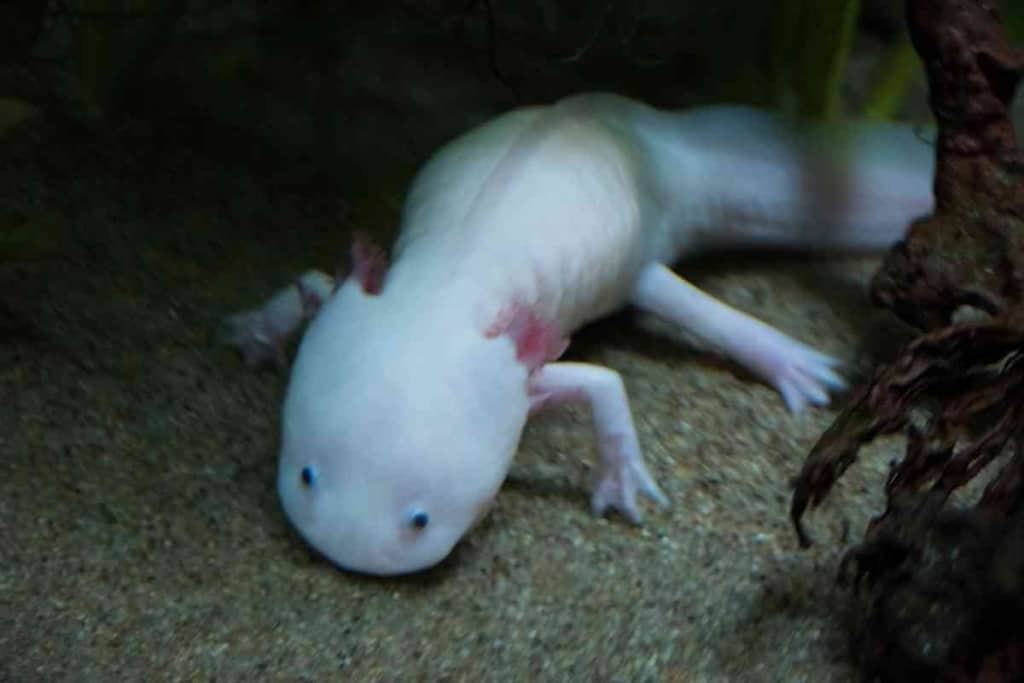
22 Fun Facts about Axolotls
Axolotls are the only amphibians that do not undergo metamorphosis; they retain their baby features.
However, this does not hinder them from living for more than 15 years. Scientists love this sea creature for its unique regeneration characteristics, whereby upon the dismemberment of its limbs, skin, or spinal cord, they regrow without leaving behind a scar or deformity.
Some of the fun facts about Axolotls would prompt you to catch a glimpse of this unique amphibian. The Axolotls live in the wild in only one place worldwide, Mexico.
The species has a dog-like head and does not grow up. Pet keepers love Axolotl because of its novelty.
1. They Don’t Grow Up
Many amphibians grow up and develop lungs, which allows them to live on land, but Axolotl remains the same. Axolotl exhibit neoteny characteristics, reaching their maturity without undergoing any metamorphosis.
Their body remains the same, from their limbs to feathery gills.
Their ability to retain all their larva features is a great survival tactic as they can sustain themselves when food is scarce.
Research shows that Axolotls reared in captivity can complete metamorphosis with a boost. Therefore, if you want them to grow up, just give them a shot of iodine, and they will undergo transition and look closely like a Tiger salamander.
The iodine gives them a hormone rush which triggers a sudden maturation, making it possible to live on the land.
Giving your Axolotl a boost to grow up might seem like a fantastic idea, but it’s best left to experts as you may kill your pet.
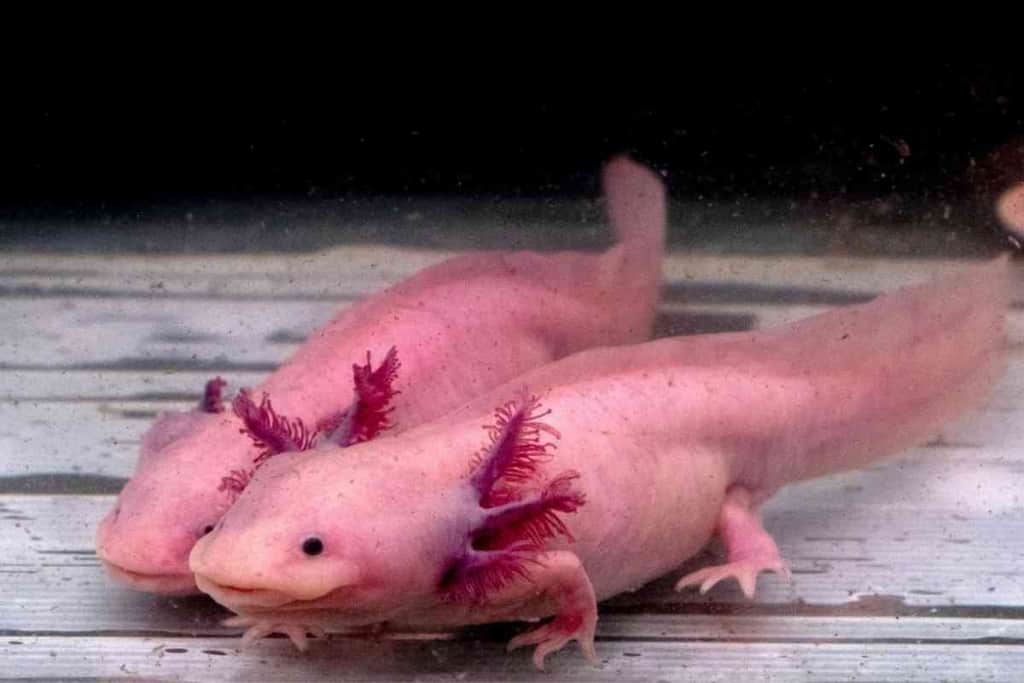
2. They Don’t Chew; they Suction their Food
Axolotls don’t develop teeth, so you may wonder how they feed. They feed through a sucking action. It interlocks its rakers to close the gill slits, allowing it to suck the food into its mouth.
They also swallow gravel during the suctioning process, which helps the amphibian grind the food.
Axolotl also uses the gravel in its body to regulate buoyancy and keep them underwater when burrowing through the substrate for food.
3. Some People Keep Them as Pets
Axolotls are an endangered species. Therefore, they are bred in captivity to preserve them from going extinct.
It is not a wonder to find aquarists keeping them as pets. They are adorable species with baby faces and various colors, providing a stunning sight.
Many pet keepers love them as they are inexpensive to feed. You can feed them with brine, bloodworms, earthworms, insects, waxworms, and pellets. Axolotls are freshwater amphibians; they can thrive in still waters without strong flowing action.
They are big creatures, measuring between 6 to 18 inches long and weighing about 10 ounces, so they need a large aquarium of about 40 liters. And because they spend most of their time at the bottom part of the tanks, it’s advisable to use fine sand as the substrate. Never place sharp stones as it could lead to injuries as they suction their food.
They are friendly creatures that pose no danger to their tankmates and owner. However, they are solitary creatures that like to keep to themselves.
They don’t even love to stay together with their own kind unless they are mating.
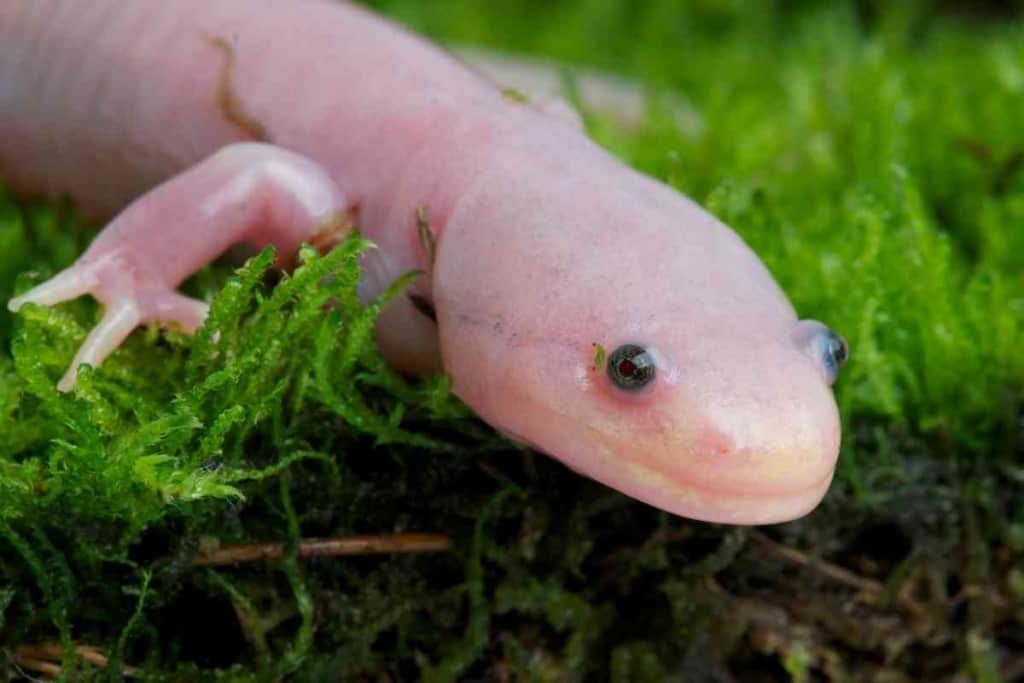
4. Axolotls Excel in Cold Waters
Axolotls are cold-blooded amphibians; therefore, they must be reared in cold water to thrive. In the wild, they survive in waters below 68 °F when it’s hot and can go below 6°C during winter.
Therefore, if you want to keep Axolotl as a pet, ensure that the water temperature ranges between 60°F and 65°f. This is important for the fish’s feeding and metabolism.
When the temperature is too low, Axolotls do not have an appetite, and thus, they have a slow metabolism.
At the same time, when the temperature is too high, they will feed, but they’re susceptible to stress and metabolic diseases, leading to their death. So water temperature plays a very vital role in the health of Axolotl.
5. They are Edible
Before they became an endangered species, the Xochimilco native would feast on them. These salamanders were a favorite, and people served them as tamales with cornmeal. Anyone who got a chance to dine on Axolotl considered it a rare treat as they have plenty of nutritional benefits.
In 1787, a traveler, Francesco Clavigero, stated that it is good to eat, but its flavor is heavenly and almost the same as that of an eel.
Although rare, you can taste Axolotl in Japan, Osaka, as there is a restaurant that serves a whole deep-fried Axolotl.
6. They Regenerate
Many amphibians and fish regenerate their tails and limbs upon dismemberment, but Axolotl takes the cup. It can regenerate its jaws, spinal cord, tissues, skin, ovary, and parts of the heart and brain. And this happens throughout their whole life.
Their regenerative ability has piqued the interest of scientists, and they are trying to understand how regeneration works to recreate this magic in human beings
In an interview with Scientific American, a professor from the University of Montreal, Stephanie Roy, stated that Axolotl regeneration is perfect.
You can sever their spinal cord, crush it or remove a segment, and it will regrow as it was previously with no scarring or deformation. They also managed to transplant organs from one Axolotl to another successfully.
In rare circumstances, In the event of a severed limb, Axolotl might grow another limb as the severed one regenerates, which leads to it having an extra limb, which adds to their novelty and thus why many pet keepers love this salamander.
7. Found in a Single Place Worldwide
Axolotls are wild creatures and are only present in one place in the world. So if you want to witness the wonders of these aquatic amphibians, make a trip to Mexico.
They were previously found in Lake Chalco in Mexico and which was later drained to avoid flooding.
Although you can still see Axolotl in Lake Xochimilco, they are rarer due to the loss of their habitat as the lake is now reduced to canals.
And they are more endangered due to the increased presence of predatory carp and tilapia. Researchers and conservationists have started breeding them in captivity to protect them from extinction.
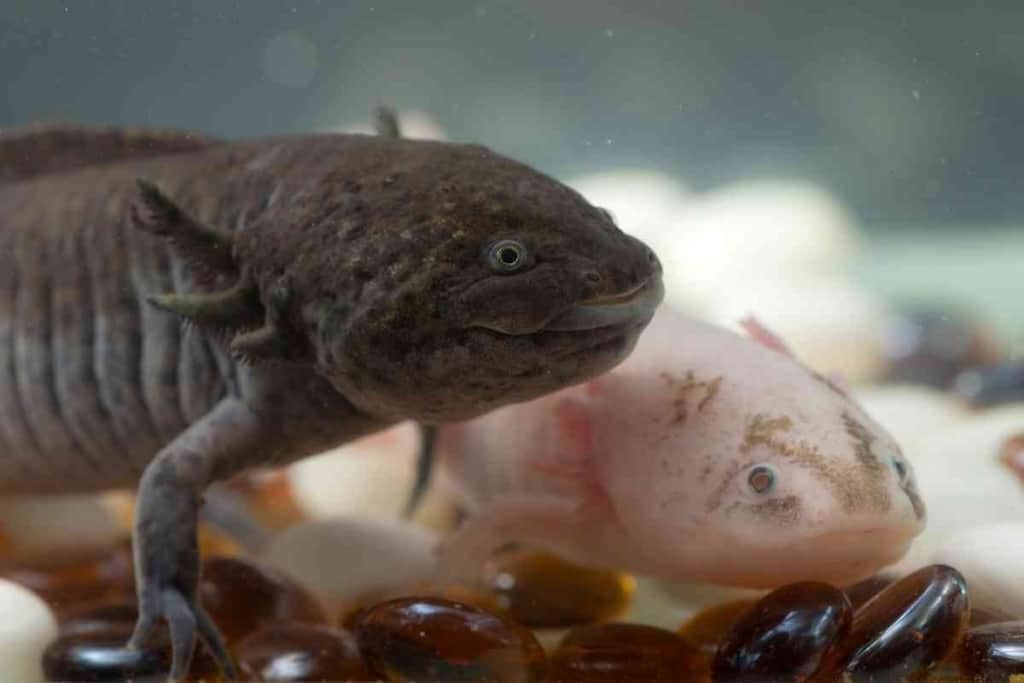
8. They Come in Various Color Patterns
Although most of the Axolotl in captivity are white, the ones found in the wild spot have a variety of colors, including brown and black. The white Axolotl are “leucistic” from a rare mutant male species shipped from Paris.
You will also find pink Axolotl with specks of gold or olive among those bred in captivity. The color variation among those found in captivity is due to breeding.
And like other salamanders, Axolotl can change their colors to adjust to their surroundings. If you look closely, you’ll notice that the feathery gills on the back of their head have a bright red shade.
This is the most notable of the “Leucistic” axolotls. They also have different eye colors, but their eyesight is not that good.
9. Unique Mating Process
It’s pretty easy to distinguish between male and female Axolotl, as the male is slightly larger. The males have a swollen posterior opening due to the location of their cloaca, while the females are flatter.
Female Axolotl has a rounder body. Especially during the breeding season as they are carrying eggs. On the other hand, the males have leaner bodies.
As they dance, the male runs around laying the sperms during the breeding season, while the female follows behind, absorbing the sperms.
10. They are Carnivorous
Although they are not picky eaters, Axolotls are carnivorous and only feed on fish. In the wild, they feed on anything that is meat from crustaceans, fish, worms, and insects.
They can feed on anything meat, dead or alive.
11. They Have a Mythical Background
Some cultures believe Axolotl to be a god from Aztec mythology. The God who leads the dead souls to the underworld.
And although there are many myths surrounding this dog-headed amphibian, it’s believed that Axolotl was afraid of being killed, which prompted it to transform into a fish to hide. And since then, it’s trapped in the water, unable to change into a land creature.
12. They are Endangered Species
Draining of Lake Chalco and the introduction of predatory fishes like carp and tilapia in Lake Xochimilco have led to the endangerment of Axolotl. Their habitat is slowly destroyed through pollution and development, pushing this exotic amphibian closer to extinction.
Researchers pushed for them to be bred in captivity to conserve Axolotl to prevent their extinction and further their research efforts. You can buy a pet axolotl for your aquarium from the breeders.
13. The Dance Through their Courtship
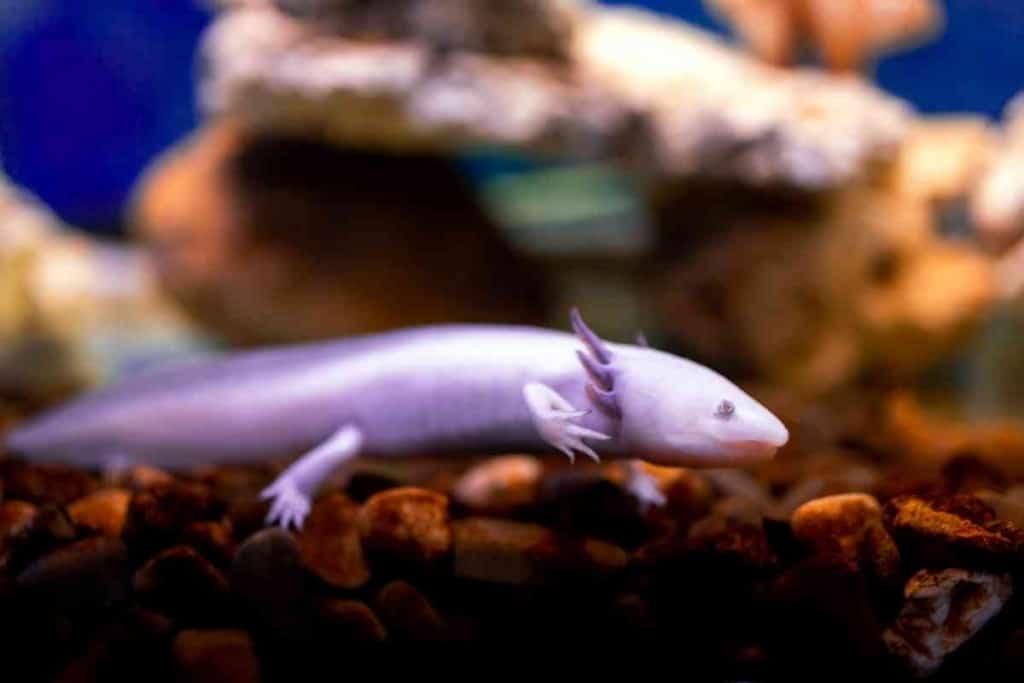
Axolotl breed at least once a year while in the wild, which happens between March and June. When Axolotl wants to breed, the male and the female Axolotl start the breeding process with a dance.
And this dance initiates their mating as they rub and slide against each other cloaca as they dance in a circular motion.
The male Axolotl then lays a jelly-like mass that holds its sperms, and the female uses her cloaca to pick up the mass, and the process is followed up by tail shaking to initiate fertilization.
After fertilization, the female lays about 100 to 300 eggs and attaches them to bedding materials, plants, and rocks to protect them from predators and being swept away by water.
The eggs hatch within 10- 14 days and juvenile Axolotl can survive on their own right after hatching.
And since Axolotl is a predator, it’s not a wonder to find it feeding on its babies. So in captivity, it would be best to separate the mother from the eggs rights after they have laid the eggs. Juvenile Axolotls feed on microscopic worms and other aquatic animals.
14. Large Genome
Axolotl features a genome that is 10 times that of a human being, and their DNA has about 32 billion bases, posing a challenge for researchers.
Scientists are having the time of their lives studying their DNA and trying to understand how they regenerate to replicate the process in human beings.
Their cell regeneration is an excellent base for scientists to expand their knowledge. They are considered ubiquitous in the labs. And they are generally the white mice of amphibians as they have a pretty exciting genome.
Their gene holds a lot of potential if unlocked for the evolution of human life to regeneration.
15. Long Life
Axolotls can live up to 15 years in their natural habitat and live for more years in captivity. Although they can regenerate their body organs, they are not immortal. This is because they can only regenerate up to five times.
Regeneration becomes impossible once they have reached the limit.
16. Axolotl Cannot Regrow Limbs 6+ Times
If an axolotl loses a limb, it can regrow it up to five times. After that, the regenerative powers of the Axolotl seem to diminish, and it is unable to regrow the limb again.
So why can’t axolotls keep regenerating their limbs indefinitely? Scientists aren’t entirely sure, but it is thought that there may be some kind of balance between the ability to regenerate and the need to grow other body parts. For example, if an axolotl kept regenerating its limbs, it might never reach full size.
17. Unique Gill Placement
Either side of the Axolotl’s head has feathery-looking branches extending from them. These are its gills. These gills allow the Axolotl to breathe underwater and absorb oxygen from the water. The gills are also used to filter out debris and keep the Axolotl’s body clean.
18. Immune To Cancer
The Axolotl is more than a thousand times more immune to cancer than mammals are. This makes them an ideal subject for research into potential cancer treatments.
19. Only In Mexico
Axolotls are found only in Mexico. The Axolotl, a permanently aquatic salamander, is native to several lakes in central Mexico. These include Lake Xochimilco, Lake Chalco, and Lake Pátzcuaro. Axolotls are also found in canals leading off of these lakes. Due to urbanization and water pollution, axolotl populations have declined sharply in recent years. In response, the Mexican government has established several protected areas for them.
20. Critically Endangered
Although the Axolotl is critically endangered, it has fewer predators than most other aquatic animals. The main predator of the Axolotl is the introduced North American river otter, which preys on them for food. Other potential predators include large fish, birds of prey, and humans. However, due to their habitats being increasingly destroyed and polluted, predation is not the biggest threat to the Axolotl population. Rather, it is humans who pose the greatest threat to this species through habitat destruction and pollution.
21. Neoteny Anatomy
This fascinating creature is actually a type of salamander that undergoes a phenomenon known as “neoteny,” which means that it retains many of the larval characteristics of its species even into adulthood.
22. Amphibians
Although they are often called “Mexican Walking Fish,” axolotls are not fish at all but are actually amphibians.
21. Easy To Distinguish Males And Females
Mexican walking fish are easily distinguished by their sex. Males have broader heads and longer tails than females. Females also tend to be larger in size overall. The easiest way to tell the difference between males and females is by looking at their cloacae, which are the openings used for reproduction and waste elimination. Male cloacae are much larger than female cloacae.
22. They Ley Eggs
The female Axolotl can lay anywhere from 12 to over 200 eggs at a time. She will find a secluded spot in order to build a nest and protect her eggs. The female Axolotl will carefully weave together plants and debris in order to make a safe space for her eggs. Once the eggs are laid, the female will guard them until they hatch.
Axolotls have external gills that allow them to breathe underwater. These gills are very delicate and can be easily damaged. For this reason, it is important for the female Axolotl to build a nest that will protect her eggs from predators and other threats.
Once the eggs hatch, the baby axolotls (known as a larva) will spend several weeks in the water before they start to grow their legs, at this stage, they will begin to look like miniature versions of their adult counterparts. Baby axolotls are very vulnerable and need to be protected from predators. The female Axolotl will often stay with her young until they are old enough to fend for themselves.
